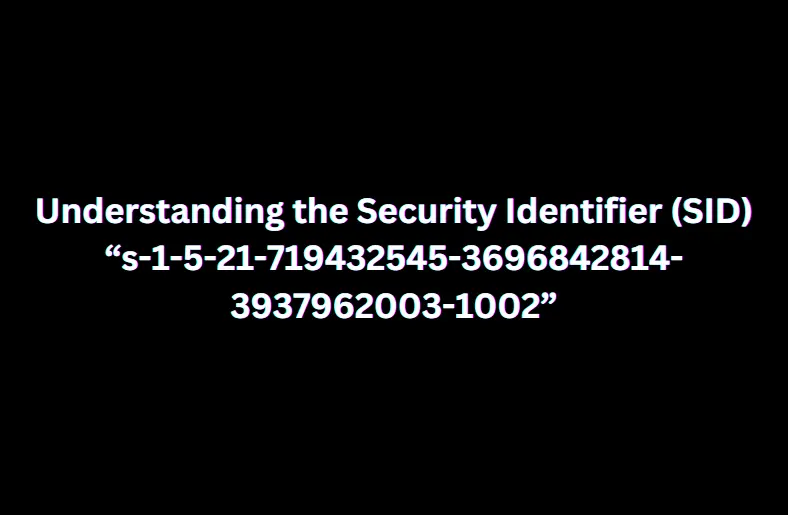Introduction
Ah, the world of digital security! It’s like the superhero of the tech realm, keeping your data safe from the villains lurking in the shadows. One of the key players in this battle is the Security Identifier (SID). Today, we’ll dive deep into the specific SID, “s-1-5-21-719432545-3696842814-3937962003-1002,” exploring its significance and how it operates in the vast ecosystem of Windows security. So, grab your cape (or maybe just a comfy chair), and let’s embark on this enlightening journey!
What is a Security Identifier (SID)?
Definition of SID
In simple terms, a Security Identifier (SID) is like a unique ID card for users and groups within Windows operating systems. Think of it as your digital fingerprint; no two SIDs are the same! Every user account or group you create gets a SID, which Windows uses to manage permissions and access to various resources.
Structure of a SID
Now, let’s break down the anatomy of a SID. The format “s-1-5-21-…” is more than just a string of numbers; it’s a well-organized classification system! Here’s how it works:
- S: This indicates the string is a SID.
- 1: Represents the revision level.
- 5: Refers to the identifier authority (usually NT Authority).
- 21: Specifies that the SID is related to a domain or a local machine.
Following this, you have a series of unique numbers (like our star of the show, 719432545, 3696842814, 3937962003) that identify specific users or groups.
The Importance of SIDs in Windows Security
User Identification
SIDs play a crucial role in identifying users and groups. Each time you log in to your computer, Windows checks your SID to determine who you are and what you can access. This unique identification helps maintain order and security in a digital landscape often riddled with confusion.
Access Control
Ever tried sneaking into a VIP section at a concert? Not so easy, right? Well, that’s what SIDs do for your digital assets. They control access to files, folders, and other resources, ensuring only the right users get in. Think of SIDs as bouncers at a club, allowing access to those on the guest list.
Auditing and Security Tracking
SIDs also help in keeping tabs on user actions. They play a pivotal role in auditing, allowing system administrators to monitor who accessed what and when. This capability is vital for identifying security breaches or unauthorized access.
Breakdown of the SID “s-1-5-21-719432545-3696842814-3937962003-1002”
General Structure Explanation
Let’s dive into the specifics of our featured SID, “s-1-5-21-719432545-3696842814-3937962003-1002.” Each component tells us a story:
- S: Marks the string as a SID.
- 1: Indicates the revision level.
- 5: Points to the NT Authority, which is responsible for the security.
- 21: This indicates it belongs to a specific domain or local machine.
The subsequent numbers (719432545, 3696842814, 3937962003) are the real stars of this show. They represent unique identifiers for user accounts or groups tied to this SID.
Subsequent Numbers
Now, you might be wondering what those digits actually mean. These numbers are like the social security numbers of the digital world, ensuring that each user or group has a unique ID. They allow Windows to differentiate between various entities, ensuring that your files and data remain securely in the right hands.
Identifying the Owner of the SID
How to Find SID Owner Information
So, how do you uncover the mystery behind our SID, “s-1-5-21-719432545-3696842814-3937962003-1002”? Fear not; it’s simpler than you think! You can use various Windows tools to find out which user or group is associated with this SID.
- Using Command Prompt: Open Command Prompt and enter the command whoami /user. This will display your current user SID.
- PowerShell: Open PowerShell and type Get-LocalUser | Select Name, SID to see a list of users and their SIDs.
Tools for SID Management
If you’re serious about SID management, several tools can make your life easier. Look for third-party software that specializes in SID management and auditing. These tools can simplify the process and provide insights into your system’s security posture.
Common Scenarios Involving SIDs
User Account Management
SIDs are crucial when managing user accounts. Every time you create, modify, or delete an account, Windows references the SID to enforce the right permissions. This ensures that every user has appropriate access levels tailored to their needs.
Group Policies
Ever wondered how group policies apply to multiple users without a hitch? Well, SIDs are the magic behind it! They help enforce policies across groups, ensuring that everyone in a team has access to the same resources, making collaboration smoother than a hot knife through butter.
Troubleshooting
Sometimes, things can go awry, and you might encounter issues related to SIDs. For instance, if you see an “access denied” error, it might be due to incorrect SID permissions. But don’t panic! Most issues can be resolved by checking the SID assignments and ensuring they align with the correct user accounts.
Security Considerations
Why Understanding SIDs Matters
Understanding SIDs is crucial for anyone working in IT or managing digital resources. They serve as the backbone of Windows security, allowing for effective user management and access control. Knowing how to work with SIDs can save you from potential headaches down the road.
Best Practices
To keep your SIDs secure, consider the following best practices:
- Regular Audits: Periodically check SIDs and permissions to ensure they align with your security policies.
- Secure Permissions: Limit SID access to only those who need it. Just like not everyone should have a key to the vault!
Risks Associated with SIDs
If not managed properly, SIDs can pose security risks. Unauthorized access, improper permissions, or orphaned SIDs can create vulnerabilities in your system. Staying vigilant is key to preventing security breaches.
Conclusion
In conclusion, the Security Identifier “s-1-5-21-719432545-3696842814-3937962003-1002” is more than just a string of numbers; it’s a vital element in the world of Windows security. Understanding its significance helps you navigate user management, access control, and auditing with ease. So, whether you’re an IT professional or a curious tech enthusiast, grasping the concept of SIDs will enhance your digital security knowledge.
Feel free to dive deeper into SID management and security practices. And if you have any questions, don’t hesitate to ask! Together, we can keep our digital worlds safe and sound.





